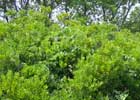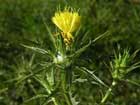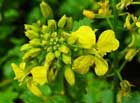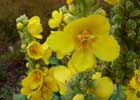Alternative Lighting: Plant Oils and Waxes
There are a number of plants, either native of Britain or able to be grown here, that can be used to provide an alternative form of lighting. Some of these plants yield a wax or an oil that can be formed directly into candles, some yield an oil that can be burnt, and others can be used as wicks. Below is a brief guide to these plants.
Wax-bearing plants:
These plants have a quantity of wax deposited upon their fruits, leaves and catkins. The wax is obtained by boiling the plant (usually only the fruit, which tends to have the greatest quantity of wax), allowing the liquid to cool and then removing the wax as it solidifies. The wax can then be re-heated and formed into candles. The remaining liquid can be used as a blue dye. All the plants listed are said to succeed in any soil, though they would probably be happier if it was a little bit acid, and for the best fruit production they should be in a fairly sunny position. The soil should be free-draining and they would appreciate watering during dry spells. The American species are quite often cultivated specifically for their wax, which burns well and is aromatic. The fruit is also edible, often being used as a flavouring in cooking.
 Myrica californica - Californian Bayberry: A hardy, evergreen shrub, native of California and growing to about 14 feet. In a severe winter (like 1985-86) it may be cut down to the ground, but it should grow away again from the base.
Myrica californica - Californian Bayberry: A hardy, evergreen shrub, native of California and growing to about 14 feet. In a severe winter (like 1985-86) it may be cut down to the ground, but it should grow away again from the base.
 Myrica cerifera - Wax Myrtle: A hardy, deciduous (occasionally evergreen) tree, native of eastern North America and growing to about 40 feet.
Myrica cerifera - Wax Myrtle: A hardy, deciduous (occasionally evergreen) tree, native of eastern North America and growing to about 40 feet.
 Myrica pennsylvanica: Very similar to M. cerifera but with a more northerly distribution which should make it more hardy. It is said to be naturalised in the New Forest, UK.
Myrica pennsylvanica: Very similar to M. cerifera but with a more northerly distribution which should make it more hardy. It is said to be naturalised in the New Forest, UK.
 Myrica gale - Sweet Gale: A hardy, deciduous shrub, native of Britain, growing to about four feet. It is found wild in bogs and marshes and is dioecious (male and female flowers are on separate plants). Unfortunately this species does not produce the same quantity of wax as its American relatives, and, with this species, it is often the leaves and catkins which are boiled to obtain the wax.
Myrica gale - Sweet Gale: A hardy, deciduous shrub, native of Britain, growing to about four feet. It is found wild in bogs and marshes and is dioecious (male and female flowers are on separate plants). Unfortunately this species does not produce the same quantity of wax as its American relatives, and, with this species, it is often the leaves and catkins which are boiled to obtain the wax.
Plants yielding an oil that solidifies:
The oil, extracted from the fruits and seeds, assumes the consistency of tallow if allowed to stand, so can be formed into candles. All the following plants will succeed in an ordinary garden soil, even if it is on the poor side. Candles made with this oil are said to burn very brightly but with a pungent smoke. Perhaps best used outside.
 Rhus glabra - Smooth Sumach: A hardy, deciduous shrub, native of North America, growing to about six feet. Dioecious, so both male and female plants must be grown (one male should fertilize about six females). The fruit is edible.
Rhus glabra - Smooth Sumach: A hardy, deciduous shrub, native of North America, growing to about six feet. Dioecious, so both male and female plants must be grown (one male should fertilize about six females). The fruit is edible.
 Rhus succedanea - Wax Tree: A deciduous tree, native of China and Japan, growing to about 30 feet. It is only hardy in the milder areas of Britain.
Rhus succedanea - Wax Tree: A deciduous tree, native of China and Japan, growing to about 30 feet. It is only hardy in the milder areas of Britain.
.jpg) Rhus verniciflua - Lacquer Tree: A hardy, deciduous tree, native of China and Japan, growing to about 30 feet. Partly dioecious. This plant is very poisonous.
Rhus verniciflua - Lacquer Tree: A hardy, deciduous tree, native of China and Japan, growing to about 30 feet. Partly dioecious. This plant is very poisonous.
Oil-yielding plants:
Many plants produce seeds that are rich in oil, and this oil can be extracted under pressure. The following list, by no means exhaustive, indicates some of the plants that can be grown in Britain and yield an oil suitable for burning.
.jpg) Brassica napus - Rape: Hardy annual, native of the Mediterranean, growing to about four feet. Widely cultivated in Britain for its seed (the all too familiar yellow fields of spring!). It succeeds in most soils. Seeds often used as the 'mustard' in mustard and cress.
Brassica napus - Rape: Hardy annual, native of the Mediterranean, growing to about four feet. Widely cultivated in Britain for its seed (the all too familiar yellow fields of spring!). It succeeds in most soils. Seeds often used as the 'mustard' in mustard and cress.
 Cannabis sativa - Hemp: Hardy annual, native of India and Iran, growing to about eight feet. It grows in any soil, but, because of some of its other properties, can only be grown under licence.
Cannabis sativa - Hemp: Hardy annual, native of India and Iran, growing to about eight feet. It grows in any soil, but, because of some of its other properties, can only be grown under licence.
 Carthamus tinctorius - Safflower: Hardy annual, native of Egypt, growing to about three feet. Does very well in a poor, dry soil in a sunny position. Flower petals are a substitute for saffron.
Carthamus tinctorius - Safflower: Hardy annual, native of Egypt, growing to about three feet. Does very well in a poor, dry soil in a sunny position. Flower petals are a substitute for saffron.
.jpg) Cornus sanguinea - Dogwood: Hardy deciduous shrub, native of Britain, growing to about 10 feet. Found wild in mixed woodland, scrub and hedgerows, preferring a calcareous soil. Can be grown as a hedge.
Cornus sanguinea - Dogwood: Hardy deciduous shrub, native of Britain, growing to about 10 feet. Found wild in mixed woodland, scrub and hedgerows, preferring a calcareous soil. Can be grown as a hedge.
.jpg) Fagus sylvatica - Beech: Hardy, deciduous tree, native of Britain, growing to about 100 feet. Prefers a chalky soil and dislikes heavy, wet soils. It makes a superb hedge but would not then produce any seed. The seeds and young leaves are edible.
Fagus sylvatica - Beech: Hardy, deciduous tree, native of Britain, growing to about 100 feet. Prefers a chalky soil and dislikes heavy, wet soils. It makes a superb hedge but would not then produce any seed. The seeds and young leaves are edible.
.jpg) Glaucium flavum - Horned Poppy: Hardy perennial, native of Britain, growing to about two feet. Found wild on shingle banks by the coast, it will succeed in any good garden soil. Said to burn very cleanly.
Glaucium flavum - Horned Poppy: Hardy perennial, native of Britain, growing to about two feet. Found wild on shingle banks by the coast, it will succeed in any good garden soil. Said to burn very cleanly.
 Guizotia abyssinica - Ramtil: Hardy annual, native of tropical Africa, growing to about six feet. It requires a rich soil and is occasionally found wild as a non-persisting casual in Britain.
Guizotia abyssinica - Ramtil: Hardy annual, native of tropical Africa, growing to about six feet. It requires a rich soil and is occasionally found wild as a non-persisting casual in Britain.
.jpg) Helianthus annuus - Sunflower: Hardy annual, native of western North America, growing to about 100 feet. It prefers a fairly rich soil and a sunny position. Seeds are edible (and very nutritious).
Helianthus annuus - Sunflower: Hardy annual, native of western North America, growing to about 100 feet. It prefers a fairly rich soil and a sunny position. Seeds are edible (and very nutritious).
 Lallemantia iberica: Hardy annual or biennial, native of Asia, growing to about one and a half feet.
Lallemantia iberica: Hardy annual or biennial, native of Asia, growing to about one and a half feet.
 Sinapis alba - White Mustard: Hardy annual, native of Britain, growing to about one foot. Found wild on sandy and calcareous soils, it is often cultivated. Seed sometimes used in mustard and cress.
Sinapis alba - White Mustard: Hardy annual, native of Britain, growing to about one foot. Found wild on sandy and calcareous soils, it is often cultivated. Seed sometimes used in mustard and cress.
The oil obtained from these plants can be burnt in an ordinary oil-burning lamp (I doubt if it would work in a pressure lamp such as the 'Tilley').
Wicks
Wicks for candles and lamps can be made from the following plants, both natives of Britain:
 Eriophorum angustifolium (Syn. E. polystachion) - Cotton Grass: A hardy perennial growing about two feet tall in peat bogs, acid meadows and marshes.
Eriophorum angustifolium (Syn. E. polystachion) - Cotton Grass: A hardy perennial growing about two feet tall in peat bogs, acid meadows and marshes.
 Verbascum thapsus - Aaron's Rod: A hardy biennial growing in sunny positions in cultivated fields and waste ground. It is also often grown in the flower garden.
Verbascum thapsus - Aaron's Rod: A hardy biennial growing in sunny positions in cultivated fields and waste ground. It is also often grown in the flower garden.
An alternative to using lamps or candles would be to slightly adapt a method of using various species of rush to provide lighting. Any species of rush that has a continuous pith can be used, though the species most favoured in the past was Juncus effusus, the Soft Rush, a hardy perennial native of Britain, growing up to five feet tall in wet pastures, bogs, damp woods etc. A very good description of the process is given in Richard Mabey's book 'Plants with a Purpose'. The method, in brief, is as follows: Harvest the stems in autumn whilst still green. Trim off both ends and then remove the outer skin. This is said to be an acquired skill. Leave a strip of skin about a third of an inch wide to act as a spinal support, then soak the stem in warm oil or molten wax for about 30 seconds. Drain and then leave to cool and set. They can be used indoors or out, give a good light, and do not drip like candles.
Database
The database has more details on these plants: Brassica napus, Cannabis sativa, Carthamus tinctorius, Cornus sanguinea, Eriophorum angustifolium, Fagus sylvatica, Glaucium flavum, Guizotia abyssinica, Helianthus annuus, Juncus effusus, Lallemantia iberica, Myrica californica, Myrica cerifera, Myrica pennsylvanica, Myrica gale, Rhus glabra, Rhus succedanea, Rhus verniciflua, Sinapis alba, Verbascum thapsus.